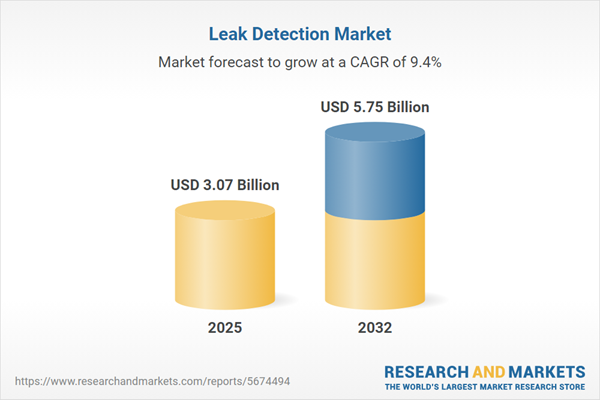Speak directly to the analyst to clarify any post sales queries you may have.
The leak detection market is evolving as organizations seek robust solutions to maintain operational performance, advance environmental initiatives, and achieve compliance in a dynamic regulatory landscape. Senior decision-makers now focus on adopting detection technologies that provide reliability and actionable insight across their operations.
Leak Detection Market Snapshot: Size, Growth, and Trends
The leak detection market is demonstrating strong growth, with a projected global valuation increase from USD 2.80 billion in 2024 to USD 3.07 billion in 2025—reflecting a robust 9.42% CAGR. This expansion is driven by multiple factors: organizations are accelerating the deployment of real-time monitoring, investing in technologies aligned with evolving compliance mandates, and integrating intelligent analytics within broader enterprise systems. Additional momentum comes from infrastructure modernization and digital transformation, as advanced analytics and automation become tools to reinforce asset reliability, support sustainability objectives, and ensure operational continuity in a competitive environment.
Scope & Segmentation in the Leak Detection Market
This research offers granular segmentation insights, assisting executives in aligning strategies for detection, capital deployment, and compliance management.
- Technologies: Acoustic emission systems, electrical potential detection, flow-based methods, helium mass spectrometry, infrared inspection tools, vacuum-focused solutions, and ultrasonic equipment offer high-precision monitoring. Businesses increasingly adopt these to reduce system downtime and improve workplace safety.
- Applications: The scope of leak detection extends to building construction, pharmaceutical manufacturing, food processing, medical contexts, oil and gas, as well as water and wastewater sectors. Each area requires specialized approaches to address regulatory, efficiency, and operational challenges.
- Offerings: Advanced hardware solutions such as custom sensors and diagnostics are paired with analytics software and professional services dedicated to installation and maintenance. This integrated approach fosters resilient, future-ready management of critical assets.
- End Use Industries: Automotive, electronics, petrochemicals, utilities, chemical production, refineries, and food production depend on tailored leak detection to maintain compliance, uphold process integrity, and enhance supply chain reliability.
- Regional Coverage: North America drives adoption in response to stringent legislative environments, EMEA focuses on harmonized regulatory frameworks, while Asia-Pacific experiences rapid technology rollout. This regional context shapes solution preferences and adoption strategies.
Knowledge of detailed segmentation empowers senior leaders to direct investments, target risk management, and address the specific demands of local regulatory landscapes.
Key Takeaways: Strategic Insights for Senior Decision-Makers
- Enterprise automation powered by IoT sensors, artificial intelligence, and digital twin technology is changing condition monitoring, helping leaders implement proactive maintenance strategies and lowering the risk of unexpected downtime.
- Monitoring changes in regulatory guidance drives organizations to invest in advanced detection, strengthening asset protection and supporting compliance management across various sectors.
- Modern leak detection systems boost environmental, social, and governance (ESG) performance, providing improved transparency and reinforcing stakeholder trust in company sustainability initiatives.
- Differing compliance requirements across regions push organizations to maintain adaptable strategies and localize technology rollouts to address risk and market opportunities effectively.
- Digitally enabled supply chains allow firms to respond quickly to procurement challenges and global trade changes, helping maintain a strategic advantage in shifting markets.
Tariff Impact: Navigating Shifting Trade Environments
Recent U.S. tariff changes encourage leak detection providers to diversify supplier relationships, expand local or regional manufacturing, and invest in modular product designs less affected by trade constraints. Companies are combining software and hardware to reduce tariff exposure or achieve compliance, opening new opportunities for strategic differentiation. Ensuring business continuity increasingly relies on agile sourcing and thorough inventory controls, as organizations confront ongoing volatility in trade policy. Continual review and refinement of supply chain geography support long-term resilience in this sector.
Leak Detection Market: Methodology & Data Sources
This analysis employs a layered approach, including secondary market research, direct interviews with senior industry leaders, and comprehensive sector surveys. All results are validated through quantitative triangulation, ensuring reliable insights for executive planning.
Why This Report Matters
- Empowers key stakeholders to anticipate and respond to technological evolution and manage regulatory risk in the leak detection market.
- Delivers evidence-based intelligence supporting robust operations, compliance fulfillment, and capital strategy execution in multiple industries.
- Prepares organizations to navigate ongoing changes in policy and supply chain dynamics within a complex global environment.
Conclusion
Targeted investment in leak detection solutions enables organizations to secure operational stability and meet shifting compliance standards. This report provides the strategic structure required to adapt and sustain value within a challenging market landscape.
Additional Product Information:
- Purchase of this report includes 1 year online access with quarterly updates.
- This report can be updated on request. Please contact our Customer Experience team using the Ask a Question widget on our website.
Table of Contents
3. Executive Summary
4. Market Overview
7. Cumulative Impact of Artificial Intelligence 2025
Companies Mentioned
The companies profiled in this Leak Detection market report include:- Honeywell International Inc.
- Schneider Electric SE
- Siemens AG
- Emerson Electric Co.
- ABB Ltd
- Baker Hughes Company
- MSA Safety Incorporated
- Teledyne Technologies Incorporated
- Thermo Fisher Scientific Inc.
- Danaher Corporation
Table Information
| Report Attribute | Details |
|---|---|
| No. of Pages | 189 |
| Published | October 2025 |
| Forecast Period | 2025 - 2032 |
| Estimated Market Value ( USD | $ 3.07 Billion |
| Forecasted Market Value ( USD | $ 5.75 Billion |
| Compound Annual Growth Rate | 9.4% |
| Regions Covered | Global |
| No. of Companies Mentioned | 11 |









